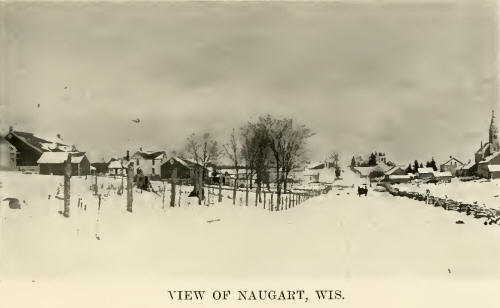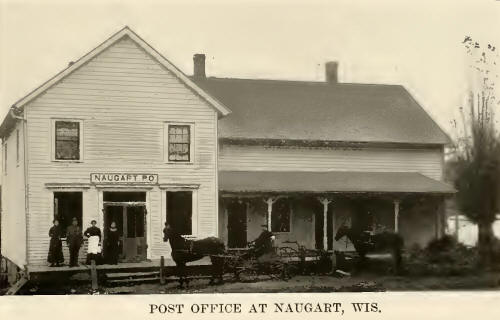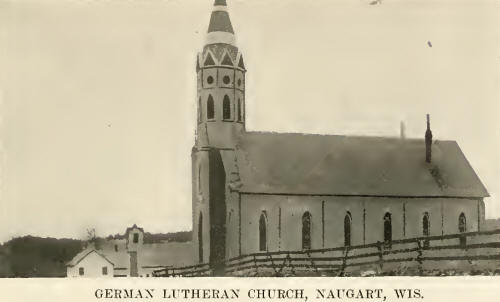
This document is not yet finished and is in need of a proof-reader. If you can help, let us know!
History: Berlin Twp., Marathon Co., Wis. (1913)
Contact:
Surnames:
----Source: History of Marathon County Wisconsin and Representative Citizens, by Louis Marchetti, 1913, pg. 542 - 546.
----Township of Berlin, Marathon Co., Wisconsin 1913 History

THE TOWN OF BERLIN.
The oldest real farm settlements were made by German fanners in the towns of Berlin, Stettin and Marathon about the same time in 1856 and 1857; not that there were no other farms in other localities, as for instance, on Mechanics Ridge in the town of Wausau, and others mentioned in chapter on "Early Settlements," but those settlements were rather of a sporadic character, made by loggers and mechanics who carried on farming only as a sort of side line to their regular lumbering employment, and who made not much progress as farmers. But the men that went into the town of Berlinóand that includes those w-ho settled in the town of Maine and a few in the town of Hamburgócame for the sole purpose of farming, intending to live by farming and make a living for themselves and their families, and grow up with the country. They all had families when they came, and few if any that ever settled in the present town of Berlin ever emigrated therefrom.
The heads of the families staid on the land, clearing and planting, letting their sons work in the pinery for some time and with the money thus earned improved their holdings, by getting stock and getting up better buildings. In ten years after the first settlements in the town of Berlin, there were already a ntimber of good farms, and a populous town, this town growing faster than any other one. But the oxteam was still the team universally used, horses being at that time not much in use, because fanners thought they could not afford to pay the high price for them, and also because horses were more expensive to keep than the oxteam.
In the size of cleared lands, the town of Berlin was far ahead of any other town in the first twenty years after settlement, but when a farm was large enough, had cleared land enough, the farmer was careful to preserve the rest of the timber, and by doing so, obtained a good price after railroads had come.
The town of Berlin was created by the county board in February, 1859, to consist of township 30, in ranges 2, 3, 4, 5 and 6, and all of township 30, in range 7, west of the Wisconsin river. The first election was held at the house of John Kopplin, and William Drost was elected chairman.
The first settlers have all gone now to their long rest, and the second generation is getting well along in years, but as a rule the land first settled upon by the pioneers is still occupied by their sons or grandsons. The buildings are exceptionally fine, good houses and barns; houses with a heating apparatus and water supply are not a rarity; the roads are in good condition all the year around, and the land in a state of high cultivation. The number of cheese factories and creameries has caused the farmers to improve their stock greatly. The town consists now of township 30, range 6 east, and is one of the smallest in the county, because the correction line on the west makes , it-a. little less than thirty-six full congressional sections. But the town is one of' the richest in the county. It is doubtful whether a single eighty acres is owned by anyone not an actual settler or occupant. There are one creamery and five cheese factories in the town, two general stores with a good stock of merchandise, one conducted at Naugart by Albert Fehlhaber, and one near the southwest corner of the town by William Beilke, both sons of pioneers.* There is located in this town a large saw mill owned by the widow of Henry Sellin, which is well stocked with logs by the fanners from Berlin and Hamburg. It has been in operation for thirty years, sawing millions of feet of pine, and there is timber enough in the towns of Berlin and Hamburg to supply the mill for twenty-five years more.

There are seven school districts, each with a good frame schoolhouse, with a course of study up to the eighth grade, open eight months a year. There are three Lutheran churches in the town, one at Naugart in the center, one at or near the northwest corner and one on the south side of the town. These three congregations were originally one, founded about fifty-two years ago, but in later years they separated at least in two.

The congregation at Naugart has a fine church, as good as can be found in the county, costing $10,500, not reckoning much of the work done and material furnished without charge by the individual members of the congregation. There is a good parsonage for the resident minister. This congregation celebrated the fiftieth anniversary of their organization and the dedication of their church (the first being a log building) on the 12th day of August, 19 10, with great festivities. There was present on that occasion the * See Little Chicago, town of Hamburg. first pastor who had assembled them together, and held missionary service, Rev. J. Strieter, who was then over eighty years of age. He had expressly come to visit his flock from Bay City, Michigan, bringing with him his wife. His voice was yet clear, although his eyesight had weakened. His sermon preached on that occasion was full of the love of God and love for man. Of course he found many changes; of the original congregation and of the men who signed the original membership roll of fifty-four, only two were left, to wit: Edward Nass and William Voigt.
The first minister at Naugart was Rev. J. J. Hoffmann, who was succeeded in 1867 by Rev. William Hudtloff, but soon afterwards the congregation separated and built a church and parsonage, and Reverend Schroedel was called as minister. Under his pastorage the present new church was built and the parsonage. He was succeeded by Rev. W. Bergholz. who remained about eight years and was followed by Rev. John Glaser, who remained with the congregation about nine years, and was succeeded by Rev. H. Brands, who directed the spiritual affairs until the year 1904, when the present minister. Rev. Theo. Hartwig, took charge of the congregation. The ministers serving this congregation also had charge of a congregation having their church edifice on or near the northwest corner of the town, which was established nearlv at the same time as the one at Naugart. The present voting strength of this congregation is 90. with 275 communicants.
The German Evangelical Lutheran Trinity church stands on land deeded by Fred Aschbrenner on the south side of the town, which church was erected in 1888 - 1889, but services were held ever since 1861 in the schoolhouse by the resident minister, J. J. Hoffmann, who had organized the Naugart congregation. There was a parsonage erected on the land of Fred Krenz which was occupied by Rev. J. J. Hoffmann and his successors. The trustees of this church are : F. Aschbrenner, H. Grewin and Louis Fehlhaber.
Rev. A. J. Koepp is the resident minister of this congregation, and occupies the parsonage, about half way between this church and the Evangelical Lutheran Immanuel church in the town of Main, which is in charge of the same minister.
There is another German Evangelical Lutheran church near the northwest comer of the town which was organized thirty years ago and which was served by the resident minister at Naugart. About twenty-five years ago the congregation built a church edifice and has become strong enough to warrant the calling for a pastor, and it will be but a short time when that church too will have its resident minister.